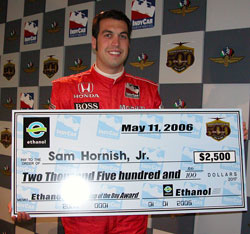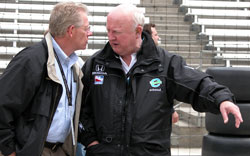 Being a farmer today has its challenges. Being a farmer and a funny car driver simply magnifies those challenges. Mark Thomas is up to the challenge though. He is also one of the biggest proponents of ethanol you’re going to find anywhere.
Being a farmer today has its challenges. Being a farmer and a funny car driver simply magnifies those challenges. Mark Thomas is up to the challenge though. He is also one of the biggest proponents of ethanol you’re going to find anywhere.
Mark is a champion too, having one 5 national IHRA titles. He was at the Indianapolis Motor Speedway for Ethanol Day. I had to wait in line to interview him as the kids and adults too stopped by for an autograph.
In my interview Mark talks about what he does for a living and how important he thinks public education about ethanol is to our country. You can to my interview with Mark here:  Mark Thomas Interview (5 min MP3)
Mark Thomas Interview (5 min MP3)


 I hope you like our event blogging. I’ve been receiving some very nice comments on it, thank you. Here’s a story about an event that’s being blogged in Africa that you might be interested to check out. Keep your eyes on Domestic Fuel too as I have a couple of events coming up that will be covered extensively.
I hope you like our event blogging. I’ve been receiving some very nice comments on it, thank you. Here’s a story about an event that’s being blogged in Africa that you might be interested to check out. Keep your eyes on Domestic Fuel too as I have a couple of events coming up that will be covered extensively. Secretary of Energy Samuel Bodman held a press conference here at Ethanol Day at the Indianapolis Motor Speedway.
Secretary of Energy Samuel Bodman held a press conference here at Ethanol Day at the Indianapolis Motor Speedway.
 The
The  Secretary of Energy Bodman (r), got to learn more about ethanol and the Rahal-Letterman Ethanol Car with driver Jeff Simmons prior to getting his turn in a car on the track. He spent quite a few minutes with Jeff at the car, pointing to various components and asking lots of questions.
Secretary of Energy Bodman (r), got to learn more about ethanol and the Rahal-Letterman Ethanol Car with driver Jeff Simmons prior to getting his turn in a car on the track. He spent quite a few minutes with Jeff at the car, pointing to various components and asking lots of questions. Our Energy Secretary found out firsthand what it feels like to crank up the RPM’s in an Indy Car. He took a couple laps with driver Davey Hamilton in a 2-seater.
Our Energy Secretary found out firsthand what it feels like to crank up the RPM’s in an Indy Car. He took a couple laps with driver Davey Hamilton in a 2-seater. Well I’m here at the Indianapolis Motor Speedway on “Ethanol Day.” The day started out wet but dried up just before the
Well I’m here at the Indianapolis Motor Speedway on “Ethanol Day.” The day started out wet but dried up just before the  he’s seen here today and says that his visit here means a great deal to him personally. As for his department, he says they’re seeking more and more ethanol to be used all through our country. The Secretary is from Illinois and this is his first visit to the track. He also made the point that ethanol helps make sure that the money spent by consumers on gas, stays here in the country. The Secretary is pictured trackside (r) with Tom Branhan, CEO of
he’s seen here today and says that his visit here means a great deal to him personally. As for his department, he says they’re seeking more and more ethanol to be used all through our country. The Secretary is from Illinois and this is his first visit to the track. He also made the point that ethanol helps make sure that the money spent by consumers on gas, stays here in the country. The Secretary is pictured trackside (r) with Tom Branhan, CEO of  I know that Cindy already mentioned this but I’m getting ready to leave one alternative fuel event for another one. The Clean Cities Congress is over but tomorrow is “Ethanol Day” in Indianapolis. I’ll be attending all the events and collecting audio and pictures to share with you. The
I know that Cindy already mentioned this but I’m getting ready to leave one alternative fuel event for another one. The Clean Cities Congress is over but tomorrow is “Ethanol Day” in Indianapolis. I’ll be attending all the events and collecting audio and pictures to share with you. The  The Congress is over but posting won’t stop. Well, maybe for a while today.
The Congress is over but posting won’t stop. Well, maybe for a while today. 
